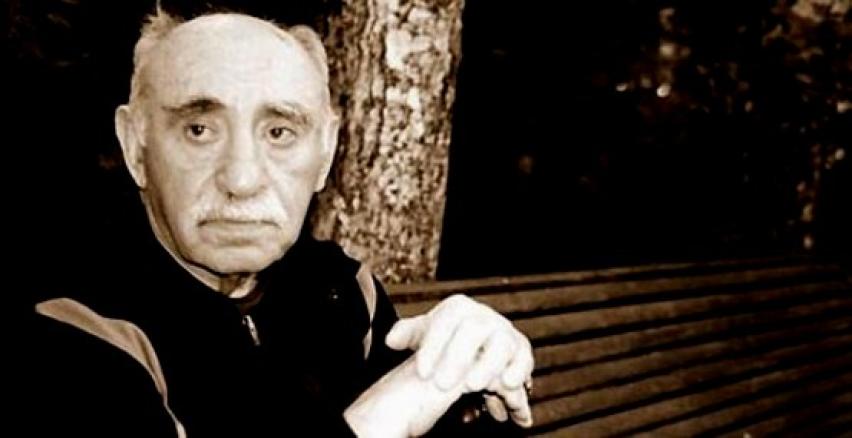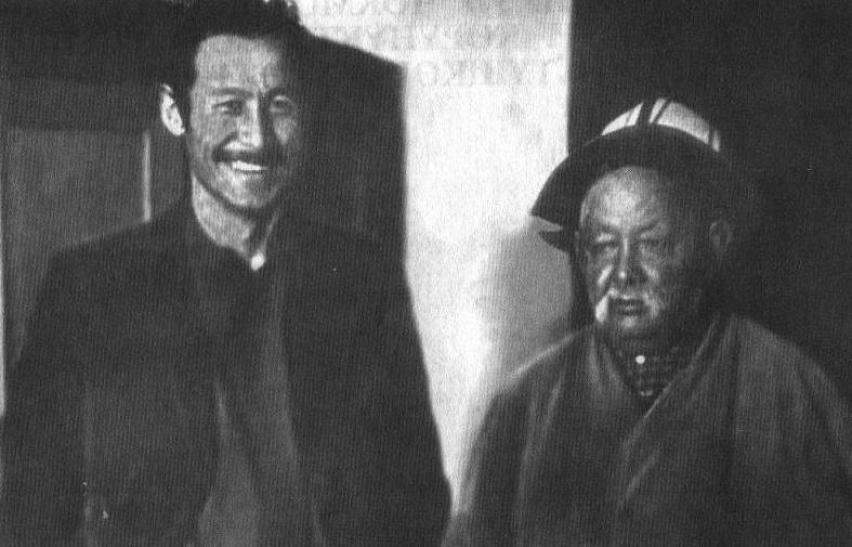Sayakbai Karalaev – Immeasurable relic of mankind

Sayakbai Karalaev is one of the greatest Manas tellers on 20th century. His interpretation of Manas poem is considered as one of the fullest and accurate versions of all time. Total volume of his work counts 500 553 rhythmic lines, which makes it the largest poem in the world.
“Greatness of a talent can be measured only by another talent” is said. Here we listed memories of Saykabai’s contemporaries that lived and known him well. These memories are allowing us now to have a look at famous figure of Manas epos singer.
Chyngyz Aitmatov used to live with Sayakbai in the same house and loved talking with him. Probably this times had inspired him to write an article “The one, who knows half-million lines of endless “Manas” and write this opinion about him:
He was a performer of an international level. Manas story-telling require much more than just ordinary story-telling skills, but talent, artistry, fantasy and creativity. Sayakbai has dedicated his whole life for mastering Manas and he truly was a living legend…
… You can’t divide epos and Karalaev, they became one long years ago. His mimics, plastics and movements serve only one purpose: tell the story of legendary epos. His voice is full of passion, his eyes are flaming and it looks like manaschy is empowered by spirits when he tells the story…
… Karalaev’s song is full of strong emotions, rhythm, passion and inspiration lead him, but suddenly – tears, sadness and sorrow. Then it follows by courage of the hero, his will and bravery. Then it repeats again…
… Sayakbai Karalaev for me is the most noticeable figure in Kyrgyz folklore, his name is the first thing that rises when I think about great sons of our nation”.
Chyngyz Aitmatov also wrote about a visit of Algerian minister of culture, Murat Burbu, who had a chance to attend one of Karalev’s performances. He was so much fascinated by it, by his talent to combine a song, a theater, a cry and storytelling in one single moment. After the performance he gave a hug to a singer and said: “That old man is a treasure of Kyrgyz nomadic culture!”.
There is also a story about Karalaev and Viktor Vinogradov, famous musicologist, who studied musical nuances of “Manas” epos by S. Karalaev. Here are his memories: He is an incredible manaschy, strong, touching and talented. His face during the storytelling becomes very concentrated and enlightened. Though he sits, he feels agile and flexible, his movements sharp and then suddenly gentle again and then reversed. His manner of storytelling is unique and original.
Epos takes us through decades of ancient history and Sayakbai is very good at passing to listened a spirit of time, of aging. He gets upset, then angers, dies and reborn again with his heroes. When events happen fast his voice fastens and raises excitement, he pronounces words sharply and vigorously. His voice is a voice of a nation, his cry is cry of mothers. When his heroes win, he celebrates with them and when they are defeated, he mourns them and shares the grief with us. There is no line in Manas that he can’t pronounce in many other ways, according to the event or heroes involved. He also capable of making sounds of several Kyrgyz musical instruments, which is incredible. Sayakbai storytelling is one of the few that you can’t resist and let it drag with him back into past.
Once at Sayakbai’s performance another famous musicologist V. Orlov said: “What a musical talent! This is incredible!”. When his colleagues offered him an interpretation to Russian language, he refused from it and said that wants to enjoy original performance and music arrangement.
In 1949 Sayakbai Karalaev took part in celebration of Kyrgyz Culture Decade in Moscow and surrounding regions and impressed many academics, writers and orientalists. Moscow writer Gennadiy Fish wrote about him: “We were amazed when that old, seemingly uneducated old man started to tell this epic story on his language and we understood him without knowing it”.
Classical translator of Manas epos Semen Lipkin recalls the time, when he started his translation of epos with help of manaschy. Before they started Sayakbai told him, that true manaschy is the one, who is blessed with pure thoughts, which makes him able to tell the story to people.
Along with his literature work he also assisted Saykabai during his tour in Russia in 1939. Saykabai was performing and Semen was translating after him. Once Semen became so much inspired by manaschy talent that he sang a small part from his Russian adaptation and Sayakbai was very impressed and told him that he is a manaschy too, a master of epos. But in Semen’s opinion Sayakbai’s best performances were made not in Russia, but in Kyrgyzstan, at his homeland. Manaschy possessed a phenomenal memory and was able to retell the epic battle scenes with fascinating details and nuances, which made his astonished listeners to awe. At the most dramatic moments manaschy jumped from the ground, shouted and waved with his hands, and his listeners were standing with him as well, completely gone into the story with him.
“Kyzyl Kyrgyzstan”, republican newspaper mentioned in 1945 that Joseph Stalin himself attended Karalaev’s performance and was impressed by his talent.
It is said that Mukhtar Auezov when he heard the touching cry of Manas wife Kanykei performed by Karalaev, cried himself and said that when Karalaev will leave his people, humanity will lose an immeasurable relic.
Lately he also called him a “Homer of XX century”, “The last of Mohicans” and often invited him to Almaty in Kazakhstan and introduced him to his students aiming to present them the magic of folklore.
“Manaschy phenomenon” was also notice by many cultural representatives. Directors and artists often talked with him, trying to capture the essence of mystery, that surrounded him. Bolot Shamshiev, Kyrgyz movie director shot a documentary film “Manaschy”, which was dedicated to Saykabai and presented it in Germany and won Gold Medal award.
During his film shooting he met often with Saykabai and thoroughly surveyed his biography and how he became a manaschy.
Another notable Kyrgyz movie director Melis Ubukeev produced a movie “Uluu manaschy” about him too.
Sculptor Turgonbay Sadykov recalls times when he was working on a sculpture of Sayakbai, but couldn’t capture the spirit of manaschy, the greatest known in Kyrgyz history. All that he saw, was just “chukodoi bolgon abyshka” which literally translates “small as sheep knee bone old man”. But then he had asked him to perform a small part from Manas epos, and picture has suddenly changed. He saw not a man naymore, but a titan, whose voice was a weapon that reaches hearts… He performed for many hours and when he stopped for a break he tunred again into a small man…















